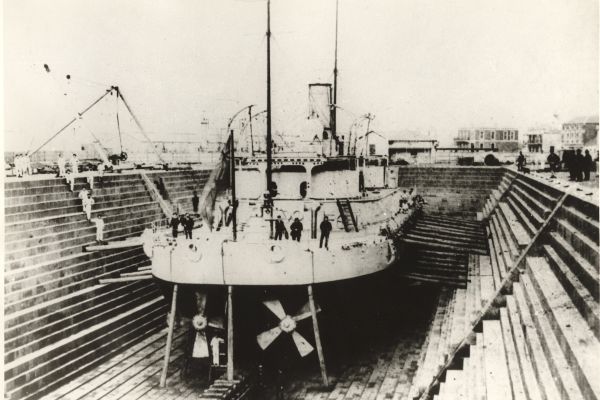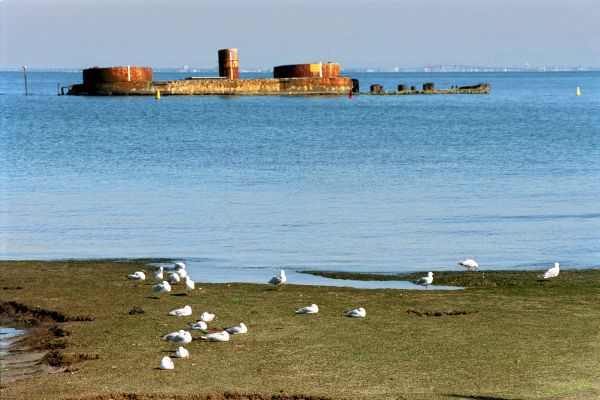

Picture by John Donegan.
Melbourne Weekly Bayside
2 August 2012
 |  |
| HMVS Cerberus in dry dock, 1874. | HMVS Cerberus as she is today. Picture by John Donegan. |
To most bayside residents, the Cerberus is just the rusting hulk that sits off shore at Black Rock. But to some it represents more than a century of Australian and maritime history.
Bayside council recently asked Heritage Victoria to change its mind about using a $500,000 federal grant – earmarked for preservation works – to establish an onshore display and a corrosion control system.
Heritage Victoria’s decision raised the ire of Friends of the Cerberus, which described it as a "death warrant" for the ship.
But why should we care what happens to the Cerberus? Friends of the Cerberus president Peter Tully says preserving the world’s only surviving monitor warship represents a unique opportunity.
“There is nothing like her left in the world," he says. "Her design was cutting-edge technology when launched in the United Kingdom in 1868 and was the forerunner of all other seagoing battleship designs that followed. She was very powerfully armed and served her entire career of more than 50 years within Port Phillip Bay – defending Melbourne."
We can thank paranoia about Russia invading Melbourne for the Cerberus. If that seems ludicrous now, in the late 1800s Victoria was awash with money from the gold rush and wool industry. The young Australian colonies still felt closely bound to Europe, which had recently felt the sting of the Russian military might in the Crimean War. It didn’t help when, in the 1860s, two Russian warships sailed into Port Phillip Bay unannounced. Turns out they were on a supply stop, but the good citizens of Melbourne were spooked.
All this happened before Australian Federation, when the only significant naval power was based in Sydney and had no intention of coming to Melbourne’s aid in the event of an invasion.
Melbourne needed protection, so in 1866 a delegation was sent to England to buy two ships. The first was the HMS Nelson, which was provided on permanent loan, and the second was to be the Cerberus.
Launched in 1868 and completed in 1870, the Cerberus was a landmark naval design. It was the first British warship to dispense with sail power, the first to be built with iron-plating protection (previously plating had been retro-fitted to existing ships) and the first to have gun turrets above deck both fore and aft. It also sat low in the water, which meant it was less of a target, and came equipped with tanks that could be flooded in order to lower the boat still further.
As a warship, its lack of sails and low freeboard – the distance between deck and waterline – made it almost useless for open water warfare, but perfect for protecting a sheltered harbour.
HMVS Cerberus arrived in Melbourne in April 1871 to much fanfare, although not everyone was enamoured. The Australian Illustrated News described it as "an elongated gasometer".
Despite its impressive military pedigree, the Cerberus never fired a shell in anger, but perhaps it served its purpose, because the Russians never did get around to invading.
Cerberus was decommissioned in 1911 but when World War I broke out it was used as a port guard ship and storage space for ammunitions and explosives.
After the war Cerberus was renamed Platypus II and towed into Corio Bay, where it was used as a supply ship for submarines. In 1924 it was sold for scrap and, after anything of value was removed, sold again to the Black Rock Sailing Club, which scuttled it in 1926 to serve as a breakwater in Half Moon Bay.
It wasn’t until the 1960s that any sort of campaign to save the Cerberus took off. In 1969 the National Trust investigated the possibility of refloating the ship, and since then three other major campaigns to save her have come and gone. Although many people have lobbied for its preservation, progress has been minimal and funding is now almost nonexistent.
Bayside council’s latest request to have the $500,000 federal grant redirected to preserving the wreck, including bracing works, may be a last-ditch attempt. The underside of the hull collapsed twice in the mid-1990s during rough seas and the Heritage Victoria maritime unit has claimed that at its current rate of deterioration, the ship may have only five to 10 years left.
Peter Tully belives the Cerberus deserves better. "She served for 50 years, an incredible record for any vessel," he says. “No other ship has such a unique link to the development of Melbourne, Victoria and ultimately Australia. She deserves a far better fate than rusting away at Black Rock."